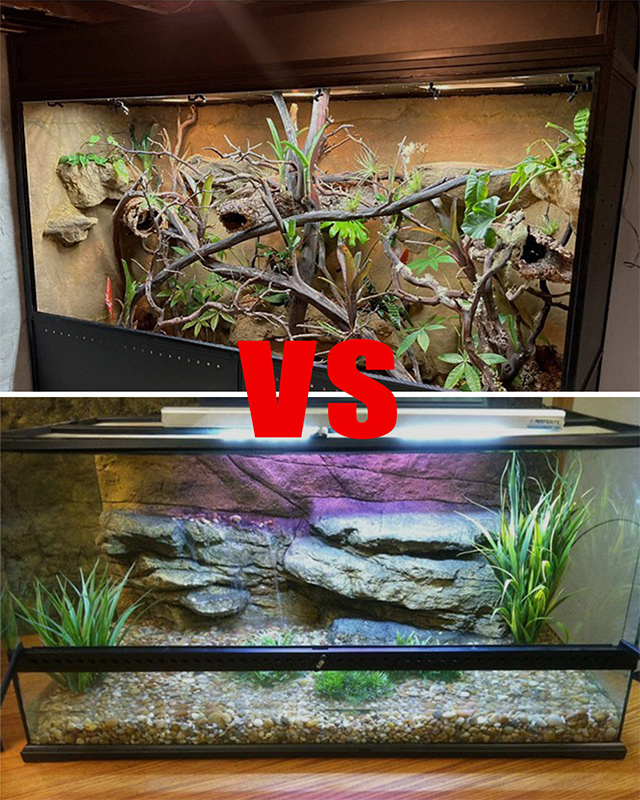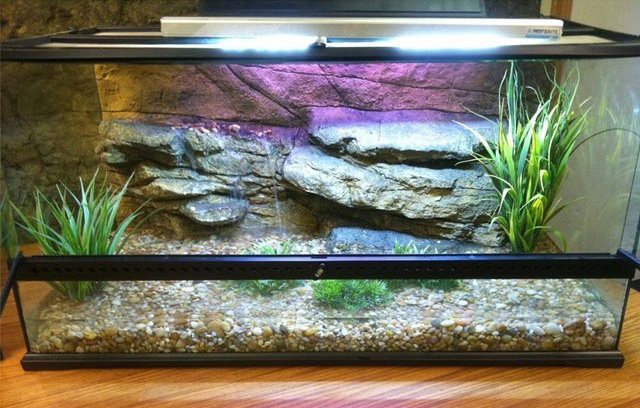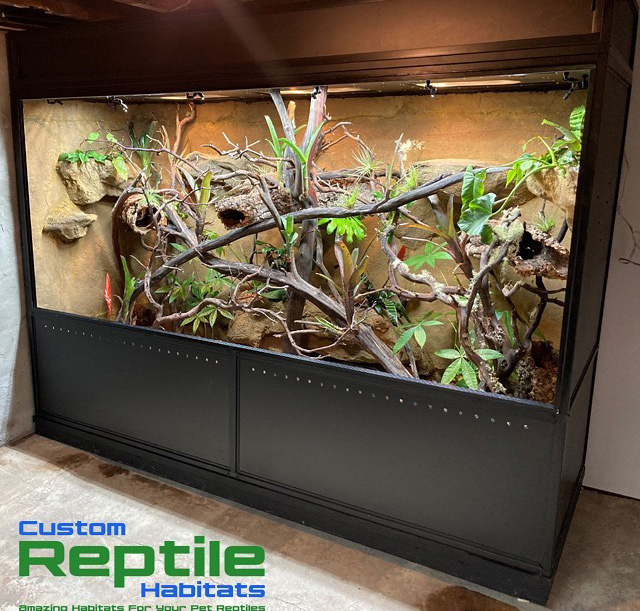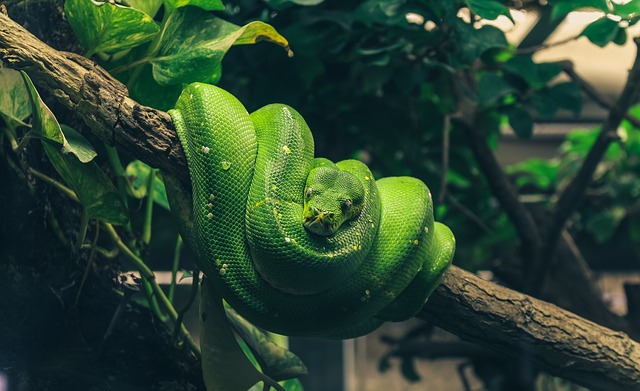PVC vs Glass Enclosures
October 29, 2020

Before you decide which enclosure will be the best fit for your reptile, you should have a basic understanding of the enclosure’s features, so you can determine which will suit your reptile’s needs more. Glass aquariums, glass terrariums, and PVC enclosures can all potentially be excellent enclosures with the right husbandry and modifications. They each have pros and cons, which we will discuss in order to help you decide which is the best match for both you and your reptile.
Glass Aquariums
Pros
Aquariums can easily be converted from fish homes into reptile homes by swapping out the old lid for a screened one. These tanks are available at almost any pet store, and can usually be found used on buy and sell sites for half the price. They’re water tight, easy to clean, and allow for overhead lighting. This way your reptile is getting their light from above as they naturally would, and they don’t run the risk of being burned on a hot bulb. Aquariums are also excellent at providing a thermal gradient throughout the tank. This is very beneficial to your reptile, as it allows them to comfortably move through different temperatures in their tank. Because they are made entirely out of glass, they can be excellent for showcasing reptiles. It also shouldn’t be too hard to buy or build a stand for your tank either, which could provide you with storage underneath.
Cons
One negative aspect of glass aquariums is that they are only top opening, which can startle many reptiles, since predators commonly come from above. You will also need to purchase clamps (which can easily be found on Amazon) to hold the lid down, preventing escapes. The glass walls are open, which may make your reptile feel vulnerable. This problem can be solved by blacking out the walls. This can be cheaply done with dark construction paper, although there are fairly inexpensive backgrounds with pretty scenery that can be stuck on with water (remember to never use tape in your enclosure, because your reptile can get stuck to it). Another downside to a glass aquarium is that they struggle to hold in heat and humidity. To combat this you can wrap ⅓ of the screen lid with either plastic wrap or tin foil. Glass Aquariums also tend to come in standardized sizes that may not be large enough to house your reptile (they normally are only 18 inches wide).
Glass Terrariums

Pros
Glass terrariums provide you with front opening doors for easy access, and a locking lid for security. They are more escape-proof than your average aquarium. They can be pricey when bought new, but can sometimes be found used on buy and sell sites for fairly cheap. Like glass aquariums, these tanks are great for showcasing reptiles, and are ideal for overhead lighting. They create a great thermal gradient throughout the tank as well. When bought new, they often come with a rock wall background. These backgrounds are a great addition to your reptile’s enclosure because they add security by blacking out one wall in the tank. They also provide enrichment by allowing your reptile to climb the wall, maximizing space in the enclosure.
Cons
Glass terrariums can be expensive when bought new, and they don’t hold heat or humidity well. A solution to this is to plastic wrap or tin foil part of the lid. Spraying the tank more often and adding moss will also help to keep humidity up. These kinds of tanks come in standardized sizes (more suited for small — medium reptiles) that may not be large enough or ideal for your reptile depending on their requirements. Although these tanks are more escape proof than your average aquarium, there have been cases of smaller snakes, such as baby corn snakes, escaping through the wiring holes. Please keep this in mind if you plan to purchase this style of tank for a smaller snake, and be sure to close the holes. Although this tank does usually come with a rock wall, you may still want to look into blacking out the side walls for extra security.
PVC Reptile Enclosure

Pros
If you’re looking for an enclosure that will maintain heat and humidity, has front opening doors, and is low maintenance, then a PVC enclosure might be a good fit for you! These enclosures are durable and lightweight, making them easy to move — plus they’re stackable! This stackability can come in handy when you’re looking at housing multiple reptiles in the same room. Another benefit for any reptile is that three of the four sides are dark, providing them with the privacy and security that they could not get in a plain glass tank. Because the tanks hold in humidity so well, they would make a great Brazilian rainbow boa or ball python enclosure. These enclosures come in a wide variety of shapes and sizes, so it shouldn't be too hard to find the right one for your reptile.
Cons
Unfortunately, these types of enclosures can be quite expensive. They can also be very hard to find second hand, so when you’re looking at one of these enclosures, you’re almost always looking at paying full price. Another obstacle to overcome is lighting. You can’t put the light over top of the tank with PVC enclosures, it won’t be beneficial. Instead the light must be mounted inside of the tank. That being said, you will need to get a wire bulb cage for your light to ensure that your reptile doesn’t burn itself. Snakes have been known to wrap themselves around light bulbs without caging in PVC enclosures and become severely burned. Additionally, the ventilation in PVC enclosures can be poor, so adding holes to increase airflow may be beneficial to your reptile, and help prevent scale rot.
Choosing the Best Reptile Enclosure
Everyone always wants to know what the “best” enclosure is, but as you can see the best enclosure for you may not be the best enclosure for someone else. Always choose an enclosure that is large enough for your reptile’s requirements — don’t settle for something that isn’t fit for them. Typically, the bigger the better, as long as you’re providing plenty of places for your reptile to hide. Each enclosure has its ups and downs, so be sure to take all of your reptile’s needs into consideration, and go with the enclosure that is best suited to fit their needs.





Sending...